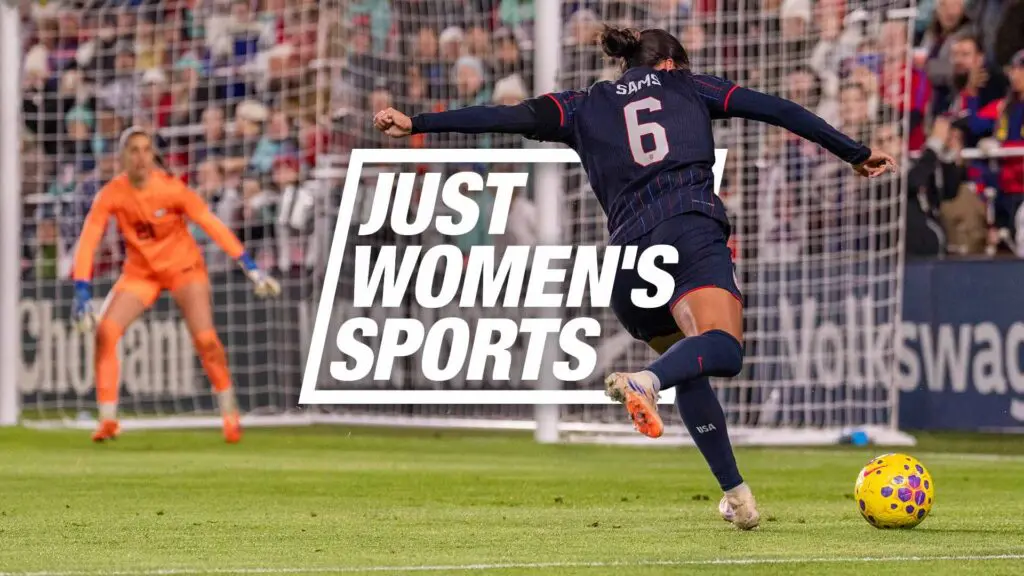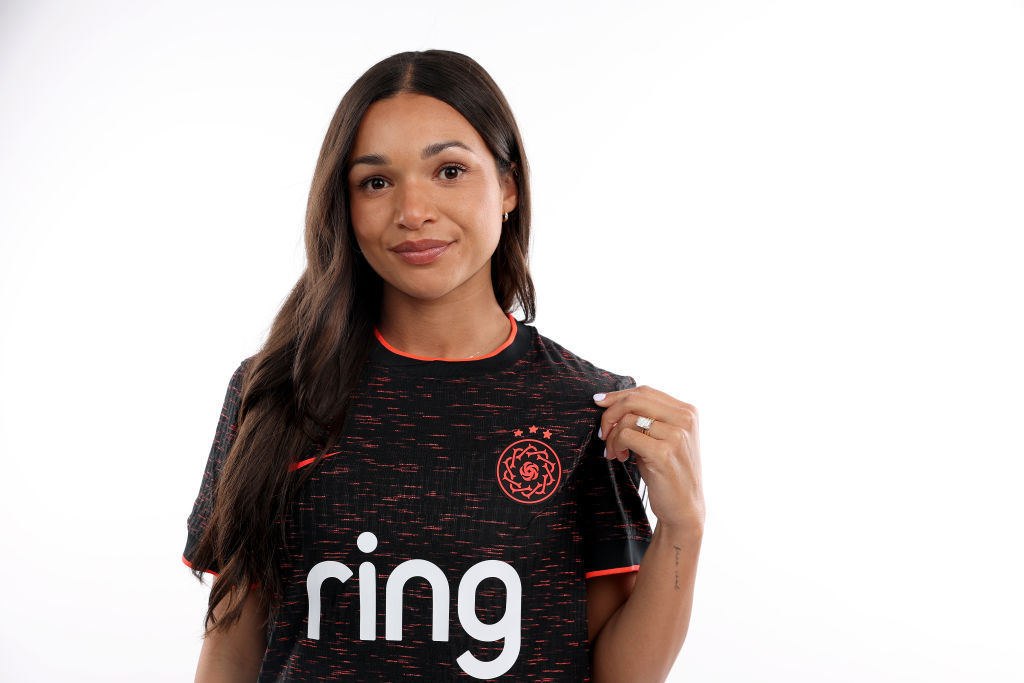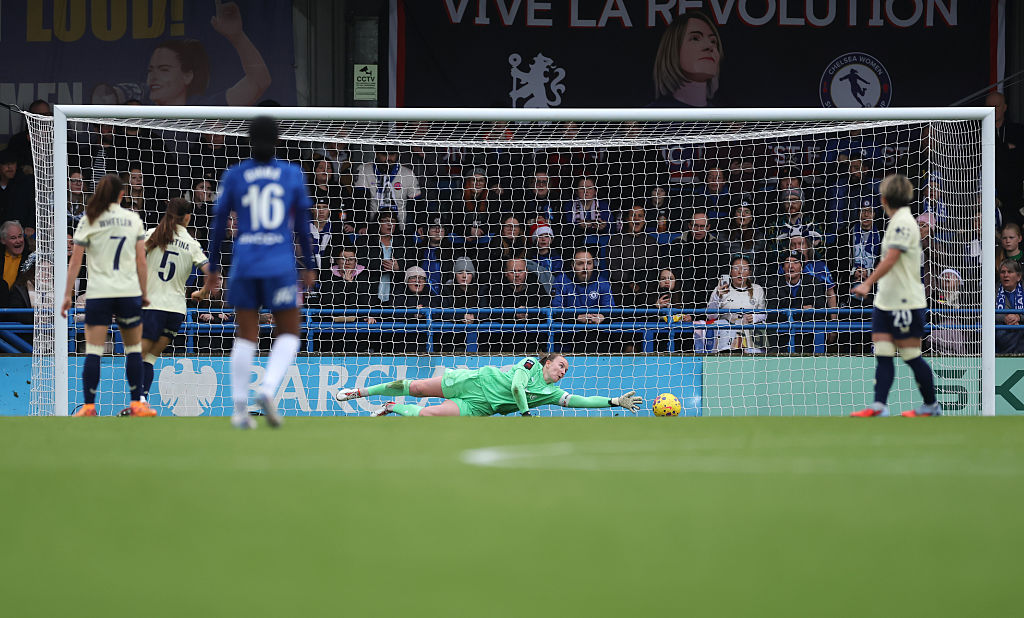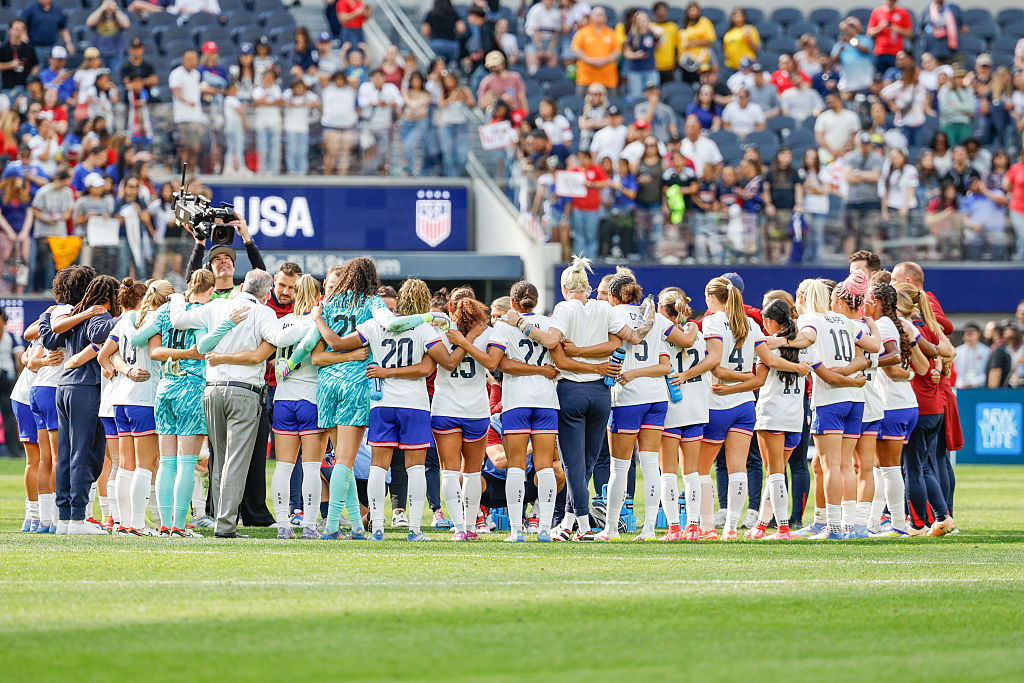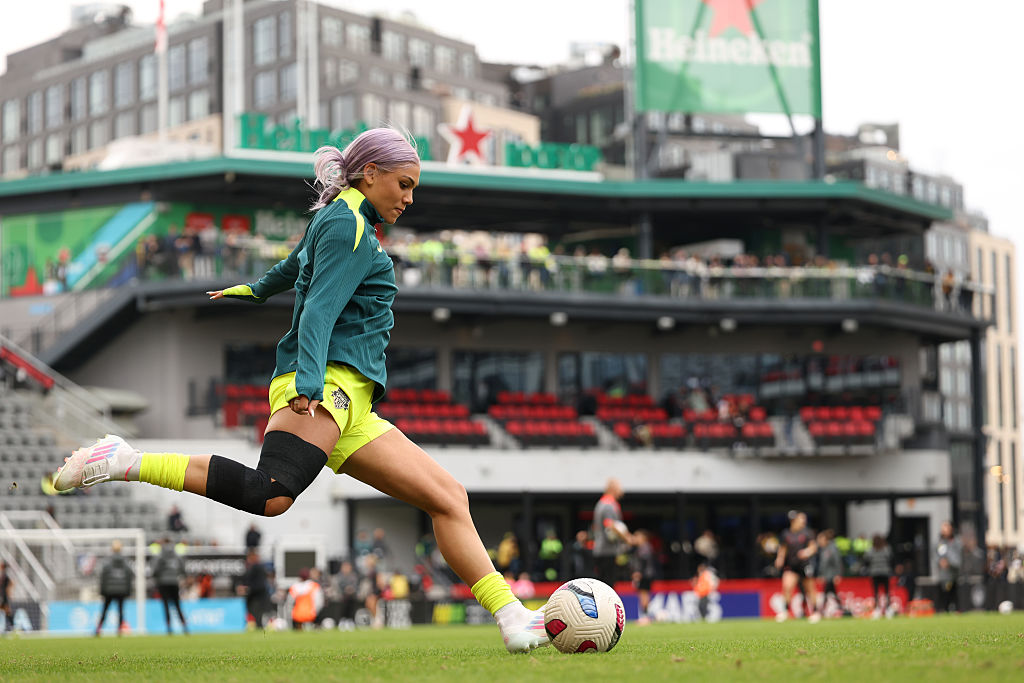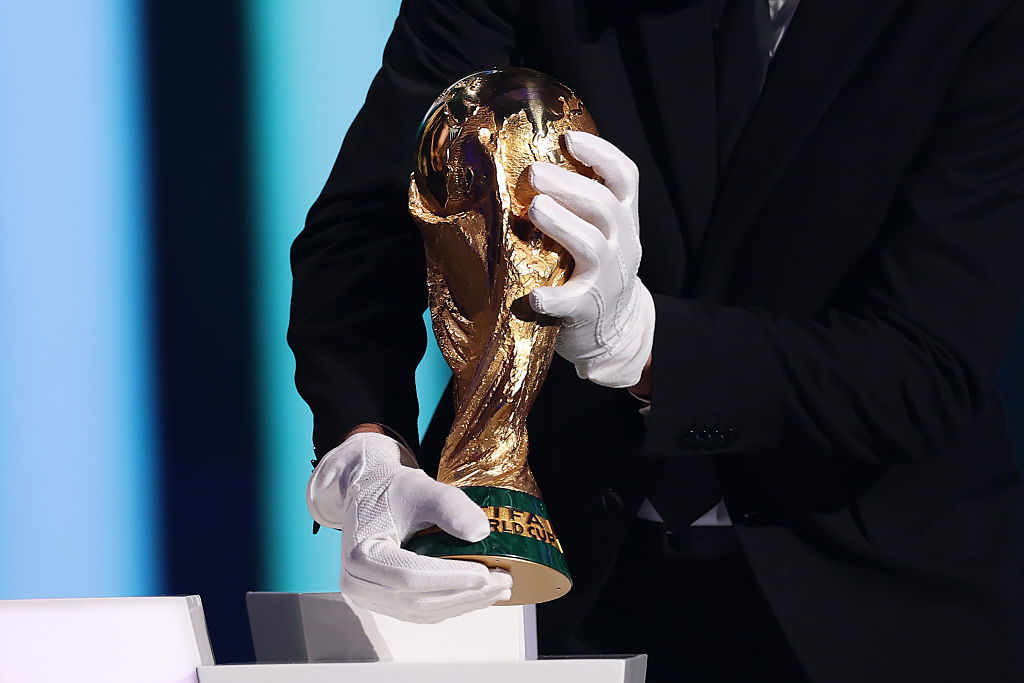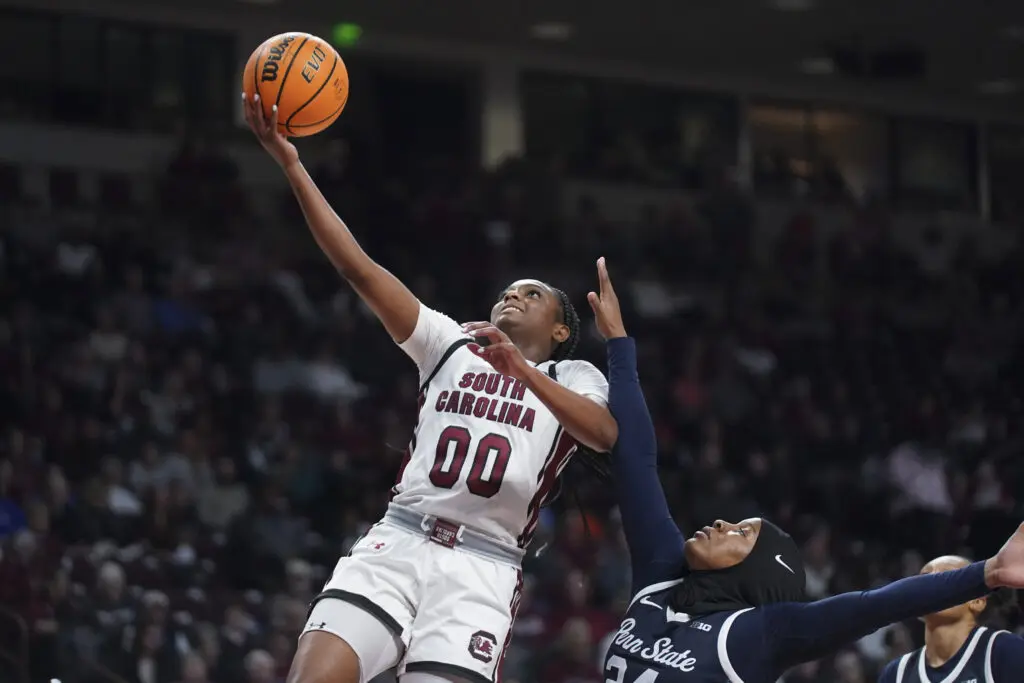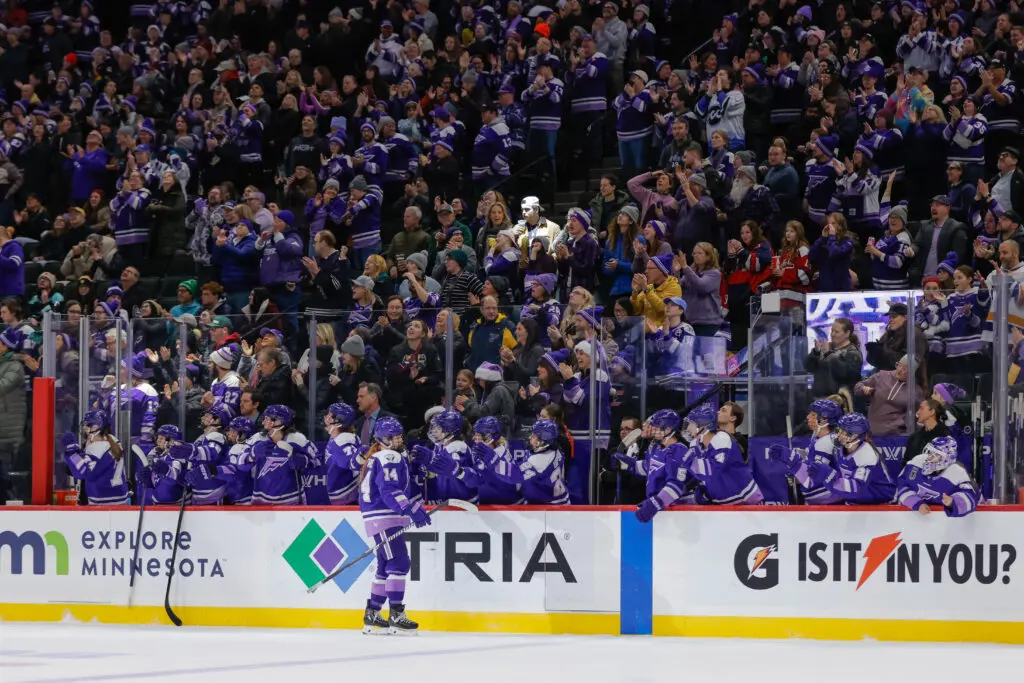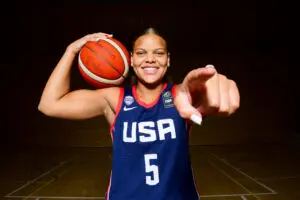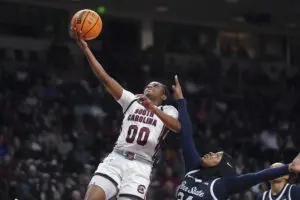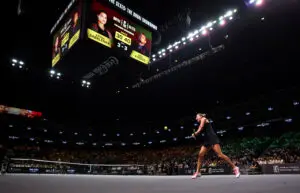As college basketball heads into the postseason and the WNBA prepares for the 2022 draft on Monday, the list of top women’s basketball prospects who have officially declared is coming into focus.
The Atlanta Dream will draft first on Monday night after acquiring the No. 1 pick from the Washington Mystics in a trade on Wednesday. In return, the Mystics received the No. 3 and No. 14 picks as well as the opportunity to swap their 2023 first-round pick with Atlanta’s. Washington originally secured the No. 1 overall pick during the WNBA Draft Lottery in December. Rounding out the top five are the Indiana Fever with the second and fourth picks and the New York Liberty with the fifth.
We have spent the past few months watching game film, combing through stats and talking to coaches and general managers to gain an accurate understanding of which players they are keeping an eye on as they prepare to make their selections on April 11. Just Women’s Sports’ WNBA Draft Big Board includes the top 50 prospects in the upcoming draft.
NOTE: This list reflects changes to the draft class since the original version was published on March 2. Several players on our initial big board opted to use their NCAA-granted fifth year of eligibility and return to school, while others officially declared for the draft since their NCAA Tournament runs came to an end.
NaLyssa Smith, F, Baylor
Smith has been playing the best basketball of her career toward the end of her senior season and has a legitimate shot to go No. 1 overall in April’s draft. The 6-foot-3 forward is a walking double-double for Baylor and one of the most effective rebounders in the country, averaging 21.8 points and 11.7 rebounds this season. Smith has expanded her game and showcased her versatility, switching from a more traditional low-block role to one where she can face up, attack off the bounce and knock down mid-range jumpers. Smith wants to run the floor and finish at the rim in transition. Her potential is what’s most appealing to WNBA GMs since she has only begun to scratch the surface of the caliber of player she can be.
NaLyssa Smith's turnaround jumper is a work of art. @NaLyssaSmith
— WSLAM (@wslam) March 1, 2022
(via @BaylorWBB) pic.twitter.com/8KKDML3Vwp
Rhyne Howard, G, Kentucky
The 6-foot-2 guard has showcased her versatility and scoring ability at all three levels while starring for Kentucky. She has the size and athleticism to make the game look effortless at times — when she kicks it into a high gear, she is nearly impossible to stop. Howard is also highly effective when coming off screens and playing within the two-woman game. Averaging 20.4 points per game this season, she has well over 2,000 points for her career. Howard led the Kentucky Wildcats to an SEC tournament championship in front of representatives from nearly every WNBA franchise, solidifying her place among the top prospects.
🚨 SCHOOL RECORD!! 🚨
— Kentucky WBB (@KentuckyWBB) February 27, 2022
8⃣ 3's for #5 today.
We told you it was her day.
📺 @SECNetwork
📻 https://t.co/IwJsrhXE7N
📊 https://t.co/GSDoiqtMYp#CommitToIt ✨ pic.twitter.com/eek9In111A
Shakira Austin, F/C, Ole Miss
At 6-foot-5, Austin has a pro-ready frame and the strength, skill and athleticism that are highly appealing to pro scouts. She’s also willing to put in the work to expand her game shows, giving her even more upside. Austin’s numbers are down, from 18.6 points per game her junior year to 15.0 this season, but the dip is less concerning given her minutes are down as well. Austin can advance the ball herself off the rebound, face up and attack off the bounce and is an effective low-post and high-post threat. She will need to continue to extend her range on the perimeter to be successful at the next level, but her defense and timing as a rim protector are already there.
Clutch shot from Shakira Austin down the stretch! ⬇️ pic.twitter.com/nP50NtXZYZ
— Ole Miss Women's BB (@OleMissWBB) February 27, 2022
Naz Hillmon, F, Michigan
The biggest question surrounding Hillmon’s readiness for the next level is whether she has the size to be a true post player in the WNBA. At 6-2, she has limited range offensively, but she’s made up for it so far with her work ethic and efficiency, having shot nearly 60 percent from the field during her four-year college career. She has a phenomenal motor and is highly effective around the rim, with an ability to be in the right place at the right time that is hard to come by. To be effective in the WNBA, Hillmon will likely need to play more of a 3/4 role and learn to score against taller defenders.
NAZ HILLMON DOING NAZ HILLMON THINGS 😤
— ESPN (@espn) February 1, 2022
Michigan up 48-36 over Indiana entering the 4th. pic.twitter.com/Nymm14ZF4N
Nyara Sabally, C/F, Oregon
At 6-5, Sabally has the unique combination of size, athleticism, strength and all-around skill that is necessary for the pros. She has been efficient during her career at Oregon, shooting 51.9 percent and averaging 14.8 points and 7.3 rebounds this season. Similar to sister Satou Sabally, the No. 2 pick in the 2020 draft, Nyara has great hands and vision as a passer, as well as the mobility to advance the ball herself or thrive in the pick-and-roll. Sabally dealt with knee injuries early on in her collegiate career, but appears to have hit her stride the past two seasons. She has lottery pick potential if she chooses to enter the draft.
Nyara Sabally rebounding, bringing the ball up, and attacking the closeout#WNBADraft #ncaaw pic.twitter.com/my7w5ksVkU
— Eric (@nemchocke) February 28, 2022
Elissa Cunane, C, NC State
Cunane has dominated the ACC for some time now in a low-block post role for NC State. She is about as consistent as any other player in the country, even though her numbers have dropped a bit this year. At 6-5, she can go to work on the block and has the range to force defenses to respect her beyond the arc, shooting 40 percent from the 3-point line during her college career. When she creates enough space to take defenders one-on-one in the post, it’s game over. Cunane would provide size, offense and rim protection down low for a WNBA team to develop next season.
That's 11-straight points for Elissa Cunane and @PackWomensBball!!#ncaaW pic.twitter.com/JFhHRoMezj
— NCAA March Madness (@MarchMadnessWBB) March 27, 2021
Rae Burrell, F/G, Tennessee
Burrell is still working her way back into full stride this season, returning to the court from a knee injury in early January. She showed what she’s capable of during a healthy junior campaign, averaging 17 points, 4.6 rebounds and 1.8 assists while shooting 45 percent from the field and over 40 percent from 3. At 6-1, Burrell has the length to play wing and make plays on defense. Burrell will be intriguing to WNBA teams because she has all the tools to be successful and hasn’t come close to hitting her ceiling.
Back-to-back buckets from Rae.
— Lady Vol Basketball (@LadyVol_Hoops) February 13, 2022
"Best scoop shot ever!" - jh#jacksontakeover
📺 @SECNetwork
📲 https://t.co/qpAk801RX3 pic.twitter.com/lpNDXgGVfl
Destanni Henderson, PG, South Carolina
As the floor general for the No. 1 team in the country, Henderson does a great job of controlling the pace and setting up the offense with strong decision-making. She has the quickness and agility to get to the rim with ease, fitting the mold of a pick-and-roll player at the next level. She has shown she can be a 3-point threat shooting 40 percent this season. Henderson makes up for her smaller 5-7 frame with her competitiveness and leadership qualities. She stayed the course during her career at South Carolina, trusting in the process and evolving into a WNBA-ready guard.
2Q: @dh3so3hd finds the edge and drives to the basket!
— GamecockWBB (@GamecockWBB) February 27, 2022
SECN: https://t.co/Ml9PzosScH
STATS: https://t.co/et56l5TdlW pic.twitter.com/QjSewrCUMG
Lorela Cubaj, F, Georgia Tech
Cubaj returned to Georgia Tech in 2021-22 for a fifth year, making the 23-year-old one of the oldest and most experienced players on the board. At 6-4, Cubaj is a high-post threat whose vision and IQ make her an effective passer. She can face up, take defenders off the bounce and create separation with her shot. Known for her defensive tenacity, Cubaj is a big reason Georgia Tech is one of the best defensive teams in the country. WNBA teams will value Cubaj’s size, facilitating, experience and energy, but she’ll need to keep developing her offensive game to make an impact in the pros.
🌟 ACC WOMEN'S BASKETBALL DEFENSIVE PLAYER OF THE YEAR 🌟
— ACC Women's Basketball (@accwbb) March 1, 2022
Lorela Cubaj, @GTWBB! 🏀🐝
📰: https://t.co/aAUI4H9sNX pic.twitter.com/045w14CNxj
Jenna Staiti, C, Georgia
Also a fifth-year senior, Staiti has the experience to go along with size and efficiency around the rim. Having committed to her conditioning, Staiti has gone head-to-head with some of the best post players in the country this season and outperformed them. The 6-4 center has good hands, understands low-block footwork and has found success as a paint defender and rim protector. She can also face up and be a threat as a passer in the high post, making her an intriguing pick-and-roll option. Staiti could improve her value by working on her range from beyond the arc, where she’s shooting just 25 percent on limited attempts.
Aisha Sheppard, G, Virginia Tech
Sheppard broke out offensively as a senior last season, averaging 17.7 points per game. Her scoring has dipped to 12.4 points per game in her fifth year, but Sheppard is a high-volume 3-point shooter (averaging 37 percent for her career) and has made big strides in her passing game. Shepard has an explosiveness to her game that could appeal to WNBA coaches, but her ability to get selected in the draft will come down to showcasing what else she can do.
Kianna Smith, G, Louisville
The long and athletic 6-0 guard is one of the best pure shooters in this draft class, averaging 38.5 percent from 3 this season. Smith’s experience as a fifth year has been vital to Louisville’s success this season. Smith is not limited in her offensive ability: Averaging 11.9 points and 2.9 assists per game this year, she uses her length well when she gets into the paint and is savvy enough to score from different angles.
Emily Engstler, G/F, Louisville
Louisville has a track record of developing players for the pros, and Engstler has a WNBA-ready edge to her. She’s gotten herself into great shape and has evolved into a versatile player on both ends of the floor. On offense, Engstler is at her best when she’s aggressive, with the length at 6-1 to exploit mismatches. On defense, she has the instincts to be disruptive and the ability to guard inside and out. Averaging 11.6 points and 9.1 rebounds on 47.6 percent shooting from the field this season, Engstler will appeal to GMs because of her versatility and untapped potential.
🗣️ PUT BACK AND ONE
— Louisville WBB (@UofLWBB) February 20, 2022
Watch @espn: https://t.co/QLenlKqddc#GoCards pic.twitter.com/AxnCMWnd5Y
Christyn Williams, G, UConn
Williams has shown flashes of how explosive and dynamic she can be offensively, but she’s also had a tendency to be streaky. The 5-11 guard is averaging 14.9 points on 46.7 percent shooting from the field as a senior, and she’s improved her 3-point shooting to 37.1 percent late in the season. When Williams is knocking down shots, she can have a significant impact on games. With her speed, she’s difficult to stop when getting to the rim in the open court and is tenacious on defense. Williams’ WNBA future will come down to whether a team thinks it can develop her into a more consistent producer.
Nia Clouden, G, Michigan State
Clouden can both initiate offense and play off the ball as a scoring guard. She has been the go-to scorer for the Spartans this season, averaging 20.4 points per game and setting a program record with 50 points in a game against Florida Gulf Coast earlier this season. Clouden has been efficient and consistent with her shot selection, pulling up for mid-range jumpers or scoring it off the bounce. She can create shots for herself, often getting to the free-throw line when she attacks opposing defenses, and manufactures points as well as any other player in this class.
Veronica Burton, G, Northwestern
Burton hit the radars of WNBA GMs after an impressive junior campaign, has carried that momentum into her senior season this year and now is arguably the best point guard in the 2022 draft class. Burton is known for her toughness and defensive tenacity, having been named the Big 10 Defensive Player of the Year the last two seasons. She plays hard, has a very high basketball IQ and can stuff the stat sheet, averaging 17.5 points, 6.5 assists and 4.1 steals in 36.3 minutes per game. The 5-9 guard has the all-around skill set and toughness to succeed, but she will need to elevate her explosiveness to be effective at the next level.
AND-OOONE 😤🤑
— Northwestern Women’s Basketball (@nuwbball) February 25, 2022
A classic @Veronicaab22 move, doesn't get better than this folks.#GoCats x #LockedN pic.twitter.com/wo1CK1b7h3
Lexie Hull, G, Stanford
At 6-1, Hull has the playmaking skills to go along with her high basketball IQ and impressive length at the guard spot. Hull is having the best shooting season of her collegiate career from beyond the arc, making 38.6 percent of her attempts. The senior is also an effective rebounder from the guard spot, pulling down 5.4 boards per game for the Cardinal. Hull is an appealing option as a tall, sharp-shooting guard, but she might struggle early on with the physicality of the WNBA. She’ll also need to adapt to the amount of ball screens at the next level since they’re not a big part of Stanford’s game plan.
Khayla Pointer, PG, LSU
Pointer is a big reason LSU has played itself back into contention this season. The fifth-year senior is one of the most experienced guards on the board (she will have played well over 4,000 minutes by the end of her career) and is known for wanting the ball in her hands in the biggest moments. At 5-7, Pointer makes up for her lack of size with her quickness and motor. She also is a phenomenal rebounder from the guard spot, reeling in 6.5 per game, and is elite at getting herself to the free-throw line. Adding to her two triple-doubles this season, Pointer leads LSU with 18.7 points per game and is shooting 37.4 percent from the 3-point line, the best mark of her NCAA career.
KP FOR THREE 🗣
— LSU Women's Basketball (@LSUwbkb) February 25, 2022
💻 https://t.co/MPChwzR8BW pic.twitter.com/wqJ2dM4CF3
Kierstan Bell, G, Florida Gulf Coast
Bell played her freshman season at Ohio State before transferring to FGCU, where she has cemented herself as one of the most prolific scorers in the nation, averaging 24.4 points per game this season. Only a junior, Bell plans to enter the 2022 WNBA Draft. A partially torn meniscus in her knee seemed to dampen her prospects, but Bell returned on Saturday less than one month after surgery. At 6-1, she has good size at the guard spot and the overall skill and strength to do well in the pros, but she’ll need to work on getting more explosive off the bounce. Her confidence and scoring ability alone, however, make her a legitimate first-round option in this draft.
Mya Hollingshed, G/F, Colorado
Hollingshed has worked really hard to become a more efficient shooter from beyond the arc, averaging 38.8 percent from 3 this season. A fifth-year senior for Colorado, she has great length at 6-3, long arms and elite athleticism and agility. The biggest concern with Hollingshed is how she will acclimate to the physicality of the WNBA. She’ll likely need to move from the 4 position to the 3 and continue to expand her ball-handling skills, which is more than possible given her work ethic. That combined with her state line of 14.4 points and 7.2 rebounds per game and her efficiency from deep make her an intriguing draft prospect.
Jade Melbourne, PG, Australia
The young, promising talent caught the eye of many elite college programs overseas. Originally committed to Arizona State in 2020, the now 19-year-old instead decided to turn pro and compete in the WNBL in her native Australia. Melbourne is a long-time member of the Australian national team and an impressive scorer at 5-10, but she’ll need to continue to develop to compete in the WNBA. Teams could view her as a long-term option, with the chance to make an impact down the road as a scoring option off the bench, and maybe even a lead playmaker.
😶 @jade_melbourne dishing no-look pass out there.@BasketballAUS 🇦🇺 | #FIBAU19 pic.twitter.com/vqNxJUDFhy
— Tom Thuillier (@tom_thuillier) August 13, 2021
Evina Westbrook, G, UConn
Westbook has good size at the guard spot and a well-rounded skill set that should make her a versatile option at the next level. Having played five collegiate seasons between Tennessee and UConn, including a redshirt year, Westbrook is one of the older and more veteran guards in the draft pool. She has been consistent for the Huskies this season, averaging 9.4 points, 3.6 assists and 3.9 rebounds per game. Her length, size, ability to facilitate and overall IQ should be appealing to any franchise looking for depth at the guard spot.
Sika Kone, F, Spar Gran Canaria
At 19 years old, Kone is one of the youngest prospects in this draft class but stands out for her impressive international resume. The 6-3 forward has competed for Spar Gran Canaria in Spain and is a member of Mali national team. At the U19 World Cup in 2021, Kone averaged 19.7 points and 14.8 rebounds per game. She is explosive on the block and has a knack for the basketball, pursuing it at will. She is still raw, but would be an appealing long-term project and asset for a team that values her strength, athleticism and physicality.
Que Morrison, G, Georgia
The fifth-year guard is a strong on-ball defender, earning her SEC Co-Defensive Player of the Year honors in 2021 and a spot on the conference All-Defensive Teams the last two seasons. Morrison averages 13.6 points per game, is a phenomenal free-throw shooter at 88.2 percent and is one of Georgia’s top 3-point shooters at 32.9 percent. She will be a great option for a franchise looking for an explosive, dynamic guard on both ends of the floor in one of the later rounds.
This was NICE 😳
— ESPN (@espn) February 13, 2022
✅ Steal
✅ Behind-the-back
✅ And-one pic.twitter.com/vsn3Jpippr
Kayla Wells, G, Texas A&M
Wells has the frame, athleticism and size to excel at the guard spot. Now in her fifth season, Wells has played the most games in Texas A&M history. She’s averaging 15.8 points per game and shooting 47.3 percent from 3, by far the most efficient mark of her career and a strong return on one of her goals heading into this season. Wells is not being talked about enough given the season she is having and could be a sleeper in this draft.
Olivia Nelson-Ododa, F, UConn
Nelson-Ododa has the length and athleticism to thrive at the forward spot in the WNBA. She can be effective in the pick-and-roll, create separation to score at the rim and run the floor well for a 6-5 forward. Defensively, she is disruptive with her length and rim protection in the lane, but she will need to get stronger to compete against WNBA bigs. Overall, Nelson-Ododa has her niche in the paint, which can be extremely valuable at the next level.
Joanne Allen-Taylor, G, Texas
A competitive and reliable off-ball guard, Allen-Taylor led the nation in minutes per game last season. At 5-8, she takes a lot of pride in her defense. Offensively, she understands pace well enough to shift over and run the point, she has a solid mid-range jumper and can finish in the paint. To separate herself in the WNBA, however, Allen-Taylor has to become a greater threat from beyond the arc.
Joanne Allen-Taylor banks it at the buzzer.
— Longhorn Network (@LonghornNetwork) November 14, 2021
Currently 15-14 Stanford with 4:30 left in the first half. pic.twitter.com/CavvuEy3V8
Kiki Smith, G, Florida
The fifth-year guard has spent the last four seasons with the Gators. Smith has a solid mid-range game and has consistently elevated her game against ranked opponents. Her stock has risen significantly as Florida has played itself into national contention this season. Offensively, Smith accelerates in transition, has a quick first step and sees the floor well. On the other end, she has the length and drive to be a great defender. Intriguing to WNBA teams is the fact that she has gotten better every year.
Jordan Lewis, G, Baylor
A sixth-year grad transfer out of Alabama, Lewis is an aggressive, versatile guard who can score and facilitate. She is smart with the ball in her hands and has an elite court vision and passing ability. Averaging 12.1 points per game for Baylor this season, Lewis has found success driving it to the rim, getting to the free-throw line and getting open beyond the arc, where she’s shooting 39.3 percent this season.
AND ONE for JLew!👌pt play!#SicEm | #GreaterThan pic.twitter.com/fGdKB19QkB
— Baylor Women's Basketball (@BaylorWBB) February 19, 2022
Queen Egbo, F/C, Baylor
Egbo stands out for her athleticism, aggressiveness on the glass and efficiency around the rim. At 6-3, she’s shooting 51.5 percent from the field during her collegiate career, and her rebounding numbers have increased every season while at Baylor. Her activity around the rim combined with her ability to defend and clean up the glass will get her looks in the WNBA. Her free-throw shooting ability has improved drastically during her senior season, but she still is not able to stretch the floor as a 3-point threat.
Vivian Gray, G, Texas Tech
The 6-1 guard has an effective jump shot and mid-range game, making her Texas Tech’s go-to player at 20.4 points per game. Gray is having a down year from beyond the arc, shooting an uncharacteristic 26.8 percent, but she has battled through injuries and inconsistencies. Gray is tough and more athletic than she gets credit for. She’s also been heating up in recent months, with three games of 30-plus points since Jan. 22.
𝐆𝐑𝐀𝐘 𝟐.𝟓𝐊 ‼️@vivian_gray_30 hits the jumper and becomes the 77th player since 1981-82 to record 2⃣5⃣0⃣0⃣ career points! #DigDeep | #WreckEm 🏀 pic.twitter.com/jjBYZrwyPf
— Lady Raider Basketball (@LadyRaiderWBB) February 26, 2022
Lexi Held, G, DePaul
Held is a hard-nosed, smart guard who is effective on both ends of the floor. She does a good job of hunting her opportunities and has proven to be one of the most prolific scorers in the Big East, shooting 39.4 percent from the 3-point line this season. Defensively, Held comes up with a lot of steals and has great anticipation. Given a chance, she could really impress at a WNBA training camp
Sam Thomas, F, Arizona
Thomas is the type of player who does a little bit of everything, but not everything she does shows up in the stat sheet. The 6-foot forward has the length and athleticism to clean up on the glass and be versatile on both sides of the ball. She is efficient at knocking down the open 3, shooting 44.9 percent from deep this season. If she can continue to expand her skill set as a scoring guard, she has all the tools to be a solid pro and is a viable option in the later rounds of the draft.
Reka Dombai, G, Hungary
At 19 years old, Dombai has already proven herself as a prolific scorer in the pros. The 5-10 guard’s production against top-level competition with her club, Gyor, has garnered the attention of international scouts for years now. Dombai’s ceiling is highly appealing, but she would likely be a long-term investment for a team if taken in this draft.
Meet 🇭🇺 Rising Star, Reka Dombai !
— EuroCup Women (@EuroCupWomen) June 6, 2020
The 17-year-old has been having some season 🔥.@uni_gyor | @Hunbasket1 | #EuroCupWomen pic.twitter.com/6p2JJzLZEH
Chloe Bibby, G/F, Maryland
In the last two seasons at Maryland after transferring from Mississippi State, Bibby has shown she can impact the game with her strength and shooting ability. The 6-2 Australian native is a strong rebounder, passer and versatile scorer. Her ability to get hot from beyond the arc will be a big selling point for teams late in the draft.
Bethy Mununga, F, South Florida
Mununga has been a walking double-double for the Bulls this season, averaging 10.8 points and 11.4 rebounds per game. At 6-foot, she is undersized to play the forward position in the WNBA, but GMs will be scouting Mununga for her athleticism, aggressiveness on the glass and willingness to outwork anyone. Likely needing to transition to wing at the next level, she has shown she can stretch the floor and knock down 3s, but she is not very efficient from deep at just 22 percent.
#15 #Texas didn't know what hit 'em tonight.
— CHRIS TORELLO (@TorelloSports) November 9, 2019
Check out this work in the paint from Bethy Mununga (@Bethy_Mng)!
BIG TIME! @USFWBB takes care of business. @NEO_WBBall #JUCO (📹: USF Athletics) pic.twitter.com/tJrEYprMh6
Maya Dodson, C, Notre Dame
The fifth-year grad transfer spent the past four years with Stanford, where she played three seasons. Dodson is playing some of the best basketball of her career for the Fighting Irish this season, averaging 12.8 points and 7.8 rebounds in maximum minutes. The 6-3 forward has yet to hit her ceiling, and with her size and athleticism, is certainly on WNBA teams’ radars. It is uncertain, however, if she’ll declare for this year’s draft.
Faustine Aifuwa, C, LSU
At 6-5, Aifuwa has the size, strength and power to provide the type of rim protection WNBA teams covet. She has to the elite ability to alter shots with her length, recording 240 blocks during her college career, the second most in LSU program history. Her offense developed over the years and she played her most efficient basketball this season, shooting 51 percent from the field.
Ali Patberg, G, Indiana
Patberg is a high-level competitor in her seventh year of college after a knee injury, redshirt transfer rules and an extra COVID-19 year extended her NCAA eligibility. Between Notre Dame and Indiana, Patberg has gained significant experience and is now the oldest player in this draft class. She has been a steady force for Indiana this season with her ability to score, create for others and lead the team through pressure situations. It would be a mistake to overlook Patberg in this year’s draft due to her all-around skill, basketball IQ and leadership.
Moon Ursin, G, Tulane
Ursin is a unique prospect from the standpoint that she can play any position on the floor. At 5-6, she is undersized in height, but makes up for it with her athleticism and agility. Ursin went from playing a complementary wing role for Baylor to running the point at times for Tulane this season. While it could be tough for Ursin to make a WNBA roster, she could be a steal for the intangibles she brings to the court, including the ability to make everyone around her better.
HUSTLE PLAYS!@MoonUrsin with the rejection!#RollWave pic.twitter.com/WOfOVMIcMb
— Tulane Women's Hoops (@GreenWaveWBB) February 23, 2022
Hannah Sjerven, C, South Dakota
A two-time Summitt League Defensive Player of the Year, Sjerven has made her mark on the mid-major scene since 2018. The 6-2 post player was one of five finalists for the Becky Hammon Mid-Major Player of the Year last season after a breakout junior campaign. This year, Sjerven’s numbers are down slightly (14.4 points and 7.4 rebounds in 24.9 minutes per game), but she is having her best 3-point shooting year after working on it during the offseason. Sjerven will need to continue to stretch her game at the next level, but she will be in the late-round conversation.
Chloe Lamb, G, South Dakota
Lamb caught a lot of attention with her play during the NCAA Tournament, where she led the Coyotes on a run to the Sweet 16. The 5-10 guard wanted the ball in her hands in key moments and came up big with clutch shots in wins over Ole Miss and Baylor. Lamb averaged 15.8 points and shot 37.4 percent from beyond the arc this season. During the best 3-point shooting season of her five-year college career in 2019-20, Lamb averaged 46.2 percent from deep.
Amber Ramirez, G, Arkansas
The fifth-year guard out of Arkansas is not afraid of the moment. She led Arkansas in scoring with 15.4 points per game this season, shot 40.2 percent from 3 and secured rebounds well from the guard spot at 4.6 per game. Named to the All-SEC Second Team, Ramirez is the type of sharp-shooting deep threat who could be a steal in the later rounds.
Iimar’i Thomas, F, UCLA
One of the most prolific scorers in the country over the last five years, Thomas compiled over 2,300 points during her career at Cincinnati and UCLA. She was second in scoring for UCLA this year, averaging 15.7 points per game. Thomas’ game has evolved every season as she’s slowly integrated a 3-point shot, shooting a career-best 40.6 percent from deep this season. At 5-10, Thomas is too undersized to be a forward at the next level, but she has all the tools to play on the perimeter or expose a mismatch on the interior with her high IQ and touch around the rim. Her flat-out scoring mentality should impress WNBA coaches.
Chelsie Hall, G, Louisville
Hall was the floor general and facilitator for the Cardinals during their run to the fourth Final Four in program history this season. A reliable playmaker, Hall takes care of the basketball on offense and has the on-ball tenacity on defense to fuel her team on the other end of the floor. She can pressure guards in the full court and wear her opponents out with how hard she plays.
WHAT A MOVE!!! Chelsie Hall ( @chelsnation12 )#MarchMadness pic.twitter.com/LF5UyIpsM0
— Antonio Garcia (@Iruk_WomenSport) March 29, 2022
Jailin Cherry, G, LSU
An elite-level athlete, Cherry has one of the most dynamic mid-range games in the country. The 5-8 guard thrived under first-year head coach Kim Mulkey, playing some of the best basketball of her career during her fifth and final year at LSU. Cherry averaged career-highs with 9.6 points, 5.2 rebounds and 2.5 assists per game this season.
Nicole Cardaño-Hillary, G, Indiana
The fifth-year guard is disruptive defensively and plays with high energy on the court. She showcased her ability to score at a high volume at George Mason, leaving after three years as the program’s all-time leading scorer with 1,766 career points. She did not carry as much scoring pressure at Indiana, where she averaged 11.6 points, 3.1 assists and 4.9 rebounds per game this season and shot 35.7 percent from the 3-point line. She is a smart facilitator with a smooth shooting stroke who could be appealing to teams in later rounds.
Macee Williams, C, IUPUI
The four-time Horizon League Player of the Year was one of the most dominant collegiate players in the country during her five years at IUPUI. The 6-2 forward averaged a double-double this year of 18.7 points and 10.7 rebounds per game and is one of the most efficient players on the board, shooting 63.8 percent from the field, which ranked fifth in the country. Williams has size, power, strength and great footwork on the interior and has become a skillful passer out of the post after being double-teamed night in and night out.
Lauren Van Kleunen, F, Marquette
Van Kleunen is one of the most experienced post players entering the draft after redshirting and playing five years at Marquette. She put up the best numbers of her career this season, averaging 13.7 points, 6.4 rebounds and 2.4 assists from the block. At 6-2, she’s not big enough to fill a traditional post player role at the next level, but she could get looks in the third round if teams believe they can develop her ability to stretch the floor and her skills on the perimeter.
Nancy Mulkey, C, Washington
Mulkey’s 6-9 length is unique in this draft class. During a six-year collegiate career at Oklahoma, Rice and Washington, she averaged 8.3 points and 6.9 rebounds per game while shooting 43 percent from the field. Despite her limited range, Mulkey brings a level of size and rim protection that are hard to come by in the league.
Rachel Galligan is a basketball analyst at Just Women’s Sports. A former professional basketball player and collegiate coach, she also contributes to Winsidr. Follow Rachel on Twitter @RachGall.

